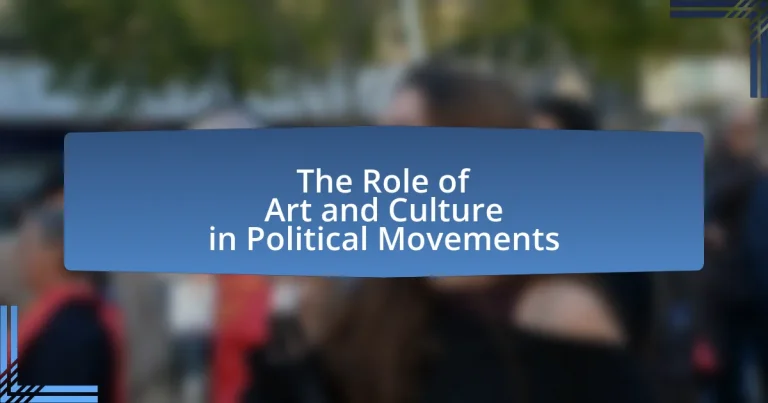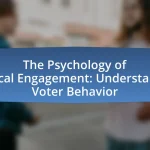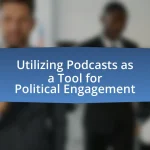The article examines the significant role of art and culture in political movements, highlighting how these mediums serve as tools for expression, mobilization, and identity formation. It discusses historical examples, such as protest songs during the Civil Rights Movement and visual art in the anti-apartheid movement, illustrating how art influences political ideologies and shapes public perception. The article also explores the impact of cultural events, grassroots movements, and emerging digital forms of art in fostering community engagement and driving social change, while addressing the challenges artists face in politically charged environments. Overall, it emphasizes the vital connection between artistic expression and political activism in shaping societal discourse and action.

What is the Role of Art and Culture in Political Movements?
Art and culture play a crucial role in political movements by serving as tools for expression, mobilization, and identity formation. They enable individuals and communities to articulate their grievances, aspirations, and visions for change, often transcending linguistic and cultural barriers. Historical examples include the use of protest songs during the Civil Rights Movement in the United States, which galvanized support and fostered a sense of unity among activists. Additionally, visual art, such as murals and graffiti, has been instrumental in conveying political messages and raising awareness about social issues, as seen in the works of artists like Banksy, who critiques societal norms and injustices. Furthermore, cultural events and performances can create solidarity and inspire collective action, as demonstrated by the role of theater in the anti-apartheid movement in South Africa. Overall, art and culture not only reflect the socio-political landscape but also actively shape and influence political discourse and action.
How do art and culture influence political ideologies?
Art and culture significantly influence political ideologies by shaping public perception and mobilizing social movements. Artistic expressions, such as literature, music, and visual arts, often reflect societal values and can challenge or reinforce political beliefs. For instance, the Harlem Renaissance in the 1920s used art to promote African American cultural identity and civil rights, influencing the political landscape by advocating for racial equality. Additionally, propaganda art, like that used in World War II, demonstrates how governments utilize cultural mediums to sway public opinion and unify citizens under a common ideology. These examples illustrate that art and culture serve as powerful tools for both expressing and contesting political ideologies, ultimately impacting societal change.
What are the historical examples of art shaping political thought?
Art has historically shaped political thought through various movements and expressions. For instance, the Dada movement emerged during World War I as a reaction against the nationalism and materialism that led to the war, promoting anti-war sentiments and questioning traditional values. Similarly, the Harlem Renaissance in the 1920s utilized literature, music, and visual arts to challenge racial stereotypes and advocate for civil rights, significantly influencing African American identity and political activism. Additionally, Picasso’s “Guernica,” created in response to the bombing of the Spanish town during the Spanish Civil War, powerfully conveyed the horrors of war and became a symbol of anti-fascism, impacting political discourse around conflict and human rights. These examples illustrate how art has not only reflected but also actively shaped political ideologies and movements throughout history.
How does cultural expression reflect societal values during political movements?
Cultural expression reflects societal values during political movements by serving as a medium through which collective sentiments, beliefs, and aspirations are articulated. For instance, during the Civil Rights Movement in the United States, music, literature, and visual arts became powerful tools for conveying messages of equality and justice, exemplified by songs like “We Shall Overcome” and the works of artists like Jacob Lawrence. These expressions not only captured the struggles and hopes of marginalized communities but also galvanized public support and awareness, demonstrating how art can mirror and influence societal values in times of political upheaval.
Why is art considered a tool for political activism?
Art is considered a tool for political activism because it effectively communicates messages, evokes emotions, and mobilizes communities around social and political issues. Throughout history, art has been used to challenge authority, raise awareness, and inspire action, as seen in movements like the civil rights movement, where artists like Nina Simone and the visual works of the Black Arts Movement played crucial roles in conveying the struggles and aspirations of marginalized communities. Additionally, art can transcend language barriers, making it a universal medium for expressing dissent and advocating for change, exemplified by street art and protest songs that resonate globally.
What forms of art are most commonly used in political movements?
Visual art, music, theater, and literature are the forms of art most commonly used in political movements. Visual art, including graffiti and posters, serves as a powerful medium for conveying political messages and mobilizing support, as seen in the street art of the Arab Spring. Music often unites people and expresses dissent, exemplified by protest songs during the Civil Rights Movement in the United States. Theater can dramatize social issues and inspire action, as demonstrated by the works of Augusto Boal in Brazil. Literature, including poetry and essays, articulates political ideologies and critiques, with authors like George Orwell influencing public thought. These art forms effectively communicate ideas, foster community, and inspire change within political contexts.
How do artists engage with political issues through their work?
Artists engage with political issues through their work by using various mediums to express dissent, raise awareness, and inspire social change. For instance, visual artists often create provocative imagery that critiques government policies or societal injustices, such as the works of Banksy, who addresses issues like war and consumerism through street art. Musicians, like Bob Dylan, have historically used lyrics to comment on civil rights and anti-war movements, influencing public opinion and mobilizing activism. Additionally, performance artists, such as Marina Abramović, engage audiences in dialogues about political themes, prompting reflection and discussion. These artistic expressions serve as powerful tools for advocacy, often reaching wider audiences than traditional political discourse, thereby reinforcing the connection between art and activism.
In what ways does culture mobilize communities for political change?
Culture mobilizes communities for political change by fostering a shared identity and collective action among individuals. Cultural expressions, such as music, art, and literature, serve as powerful tools for raising awareness about social issues and inspiring activism. For instance, the Civil Rights Movement in the United States utilized music and art to unify participants and communicate messages of resistance and hope, exemplified by songs like “We Shall Overcome.” Additionally, cultural events and festivals can galvanize community participation, as seen in the global Women’s March, where art and performance played a significant role in mobilizing diverse groups to advocate for gender equality. These cultural practices not only enhance community solidarity but also amplify political messages, making them more accessible and resonant with broader audiences.
What role do cultural events play in raising political awareness?
Cultural events play a significant role in raising political awareness by providing a platform for dialogue, expression, and community engagement. These events, such as art exhibitions, music festivals, and theater performances, often address social and political issues, encouraging participants to reflect on their societal context. For instance, the 2017 Women’s March featured various cultural performances that highlighted gender equality and social justice, mobilizing thousands to advocate for political change. Additionally, studies show that cultural events can increase civic participation; a report by the National Endowment for the Arts found that individuals who engage in arts and culture are more likely to vote and participate in community activities. Thus, cultural events serve as catalysts for political consciousness and action.
How does community art foster collective identity in movements?
Community art fosters collective identity in movements by creating shared experiences and visual representations that resonate with the values and struggles of a group. This form of art often reflects the community’s history, culture, and aspirations, thereby reinforcing a sense of belonging and unity among its members. For instance, murals and public installations can serve as powerful symbols of resistance and solidarity, as seen in the civil rights movement where artists used visual storytelling to communicate messages of equality and justice. Such artistic expressions not only engage community members but also attract wider attention, amplifying the movement’s message and fostering a collective identity that is recognized both locally and globally.
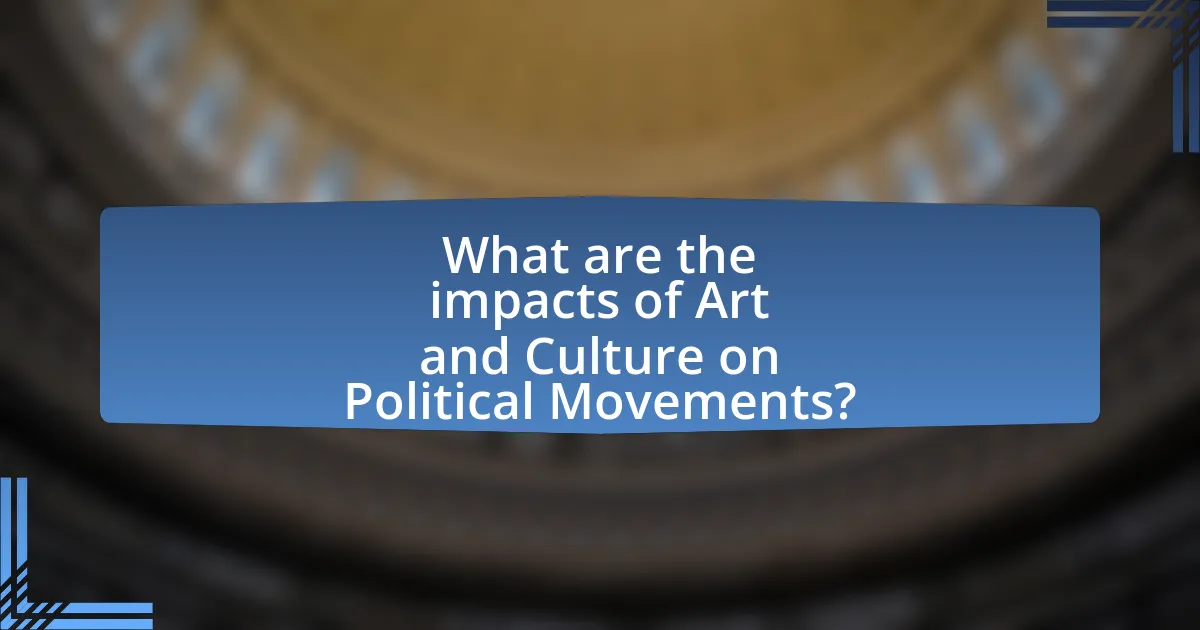
What are the impacts of Art and Culture on Political Movements?
Art and culture significantly influence political movements by shaping public perception, mobilizing communities, and providing a platform for dissent. For instance, the use of music, literature, and visual arts in the civil rights movement in the United States helped to articulate the struggles and aspirations of marginalized groups, fostering solidarity and activism. The song “We Shall Overcome” became an anthem for the movement, encapsulating its goals and energizing participants. Additionally, cultural expressions such as graffiti and street art during the Arab Spring served as powerful tools for protest, conveying messages of resistance and hope while bypassing state censorship. These examples illustrate how art and culture not only reflect societal issues but also actively participate in the political discourse, driving change and inspiring action.
How does art create emotional connections in political contexts?
Art creates emotional connections in political contexts by evoking feelings and fostering empathy among audiences. Through visual imagery, music, and performance, art can encapsulate complex political issues, making them relatable and accessible. For instance, the use of protest songs during the Civil Rights Movement in the United States, such as “We Shall Overcome,” galvanized support and united individuals around a common cause, illustrating how art can mobilize emotions and inspire collective action. Additionally, visual art, like the works of Francisco Goya, has historically depicted the horrors of war and oppression, prompting viewers to confront uncomfortable truths and engage emotionally with political realities. These examples demonstrate that art serves as a powerful medium for emotional engagement, facilitating deeper connections to political movements and their underlying messages.
What psychological effects does art have on political engagement?
Art significantly enhances political engagement by evoking emotional responses and fostering a sense of identity among individuals. This emotional connection can motivate people to participate in political activities, as art often reflects societal issues and inspires collective action. For instance, studies have shown that exposure to politically charged art can increase awareness and empathy towards social injustices, leading to higher rates of civic participation. Research by the University of California, Berkeley, indicates that individuals who engage with art related to political themes are more likely to discuss these issues and mobilize for change, demonstrating the powerful psychological impact art has on political engagement.
How do visual arts and performances evoke public response?
Visual arts and performances evoke public response by engaging emotions, provoking thought, and fostering dialogue. These forms of expression often reflect societal issues, enabling audiences to connect personally with the themes presented. For instance, the use of powerful imagery in protest art can galvanize support for social movements, as seen in the works of artists like Ai Weiwei, whose installations critique government policies and human rights abuses. Research indicates that art can stimulate empathy and awareness, leading to increased civic engagement; a study published in the Journal of Arts Management, Law, and Society found that audiences exposed to socially relevant art were more likely to participate in community activism. Thus, visual arts and performances serve as catalysts for public response by making complex issues accessible and relatable.
What challenges do artists face in politically charged environments?
Artists face significant challenges in politically charged environments, including censorship, repression, and the risk of persecution. Censorship often limits artistic expression, as governments or organizations may suppress works that critique political regimes or social injustices. Repression can manifest through intimidation or violence against artists, as seen in countries like Iran, where artists have faced imprisonment for their work. Additionally, the risk of persecution can deter artists from addressing controversial topics, leading to self-censorship and a stifling of creative freedom. These challenges hinder the ability of artists to engage in meaningful political discourse and can diminish the impact of art as a tool for social change.
How does censorship affect artistic expression in political movements?
Censorship significantly restricts artistic expression in political movements by limiting the ability of artists to convey dissenting views and critique authority. When governments impose censorship, they often target works that challenge the status quo, leading to self-censorship among artists who fear repercussions. For instance, during the Tiananmen Square protests in 1989, the Chinese government suppressed artistic works that depicted the movement, stifling voices that could inspire change. This suppression not only diminishes the diversity of perspectives in the cultural landscape but also undermines the potential for art to mobilize and unify people around political causes. Historical examples, such as the censorship of literature and visual arts in authoritarian regimes, illustrate how the restriction of artistic expression can weaken political movements by silencing critical narratives and reducing public engagement.
What risks do artists take when addressing political issues?
Artists face significant risks when addressing political issues, including censorship, legal repercussions, and personal safety threats. Censorship can manifest through government restrictions or social backlash, limiting the artist’s ability to express their views. Legal repercussions may arise from laws that penalize dissenting opinions, as seen in countries with strict anti-protest laws. Additionally, artists may encounter threats to their personal safety, particularly in oppressive regimes where dissent is met with violence. Historical examples include the persecution of artists in totalitarian states, such as the Soviet Union, where many faced imprisonment or exile for their political expressions. These risks highlight the precarious position artists occupy when engaging with political discourse.
How can art and culture contribute to social change?
Art and culture can contribute to social change by raising awareness, fostering dialogue, and inspiring action among communities. Through various forms such as visual arts, music, and literature, artists can highlight social injustices and provoke critical discussions. For instance, the Civil Rights Movement in the United States saw artists like Nina Simone and James Baldwin use their platforms to address racial inequality, effectively mobilizing public sentiment and support for change. Additionally, studies show that cultural expressions can enhance community cohesion and empower marginalized voices, as seen in the global impact of movements like the Arab Spring, where art played a crucial role in uniting people against oppressive regimes.
What are successful case studies of art leading to political reform?
Successful case studies of art leading to political reform include the role of the “Guernica” painting by Pablo Picasso, which became a powerful anti-war symbol following the bombing of Guernica during the Spanish Civil War in 1937. This artwork galvanized international attention and contributed to the discourse on the atrocities of war, influencing public opinion and political action against fascism.
Another significant example is the “AIDS Memorial Quilt,” which emerged in the 1980s as a response to the AIDS crisis in the United States. The quilt not only memorialized those lost to the disease but also raised awareness and prompted political action for healthcare reform and funding for AIDS research, ultimately leading to significant policy changes.
Additionally, the “Femen” movement, which uses provocative performance art to advocate for women’s rights and political reform, has successfully drawn global attention to issues such as gender inequality and reproductive rights, influencing legislative changes in various countries.
These case studies illustrate how art can effectively mobilize public sentiment and drive political reform by raising awareness, fostering dialogue, and inspiring action.
How do grassroots movements utilize art for advocacy?
Grassroots movements utilize art for advocacy by creating powerful visual and performance-based expressions that communicate their messages and mobilize communities. These artistic forms, such as murals, street performances, and music, serve to raise awareness, inspire action, and foster a sense of identity among participants. For instance, the “Black Lives Matter” movement has effectively used art, including murals and social media campaigns, to highlight systemic racism and police violence, thereby engaging a broader audience and encouraging public discourse. This approach not only amplifies their message but also builds solidarity and community resilience, as evidenced by the widespread participation in art-related protests and events.
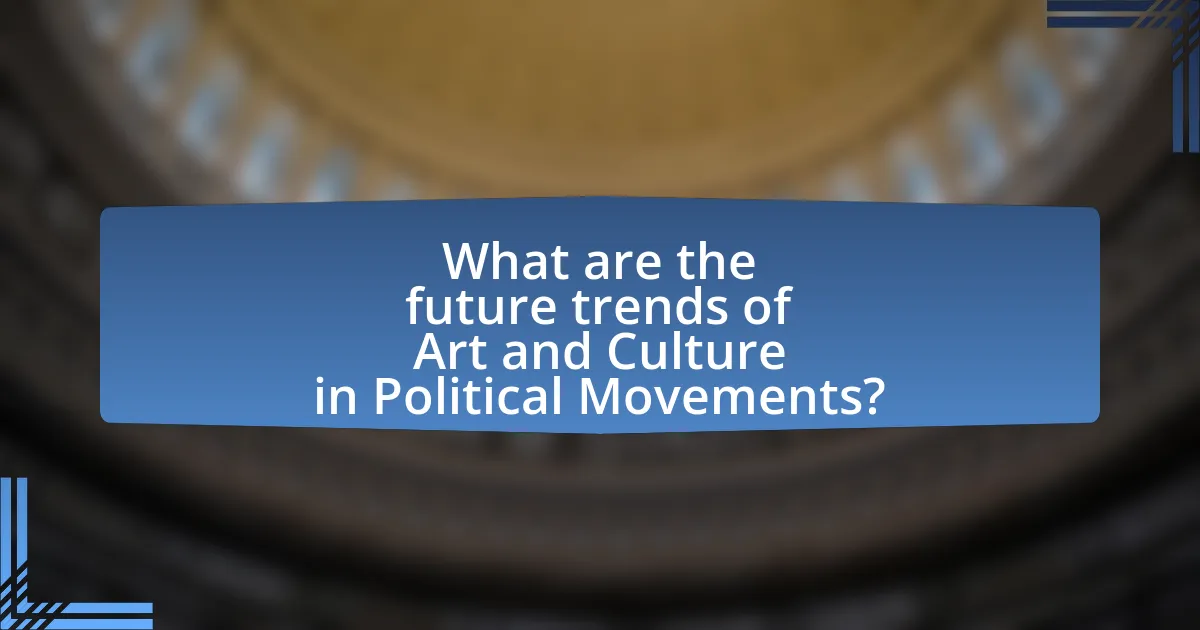
What are the future trends of Art and Culture in Political Movements?
Future trends of art and culture in political movements will increasingly focus on digital activism and participatory art forms. As technology evolves, artists will leverage social media platforms and virtual reality to engage wider audiences and create immersive experiences that reflect social issues. For instance, movements like Black Lives Matter have utilized digital art and memes to spread their messages rapidly and effectively. Additionally, collaborative projects that involve community participation will gain prominence, as they empower marginalized voices and foster collective action. This shift is supported by the rise of grassroots movements that prioritize inclusivity and representation, demonstrating that art and culture will continue to be vital tools for social change in the political landscape.
How is technology changing the landscape of political art?
Technology is transforming the landscape of political art by enabling artists to reach wider audiences and engage in more interactive forms of expression. Digital platforms, social media, and multimedia tools allow for the rapid dissemination of political messages, making art more accessible and participatory. For instance, the use of virtual reality and augmented reality in installations can immerse viewers in political narratives, enhancing emotional engagement and understanding. Additionally, data visualization techniques can present complex political issues in visually compelling ways, facilitating public discourse. The rise of online crowdfunding has also empowered artists to finance politically charged projects independently, bypassing traditional gatekeepers. These technological advancements have fundamentally altered how political art is created, shared, and experienced, fostering a more dynamic and inclusive dialogue around social and political issues.
What role do social media platforms play in political art dissemination?
Social media platforms serve as crucial channels for the dissemination of political art by enabling artists to reach wider audiences and engage in real-time dialogue. These platforms facilitate the rapid sharing of visual content, allowing political art to gain visibility and provoke discussions on pressing social issues. For instance, during the Arab Spring, artists utilized platforms like Facebook and Twitter to share politically charged artwork, which contributed to mobilizing public sentiment and activism. Additionally, studies show that social media can amplify the impact of political art, as seen in campaigns like #BlackLivesMatter, where visual art became a powerful tool for advocacy and awareness.
How are digital artists influencing contemporary political discourse?
Digital artists are influencing contemporary political discourse by creating impactful visual narratives that engage audiences and provoke critical thought. Through platforms like social media, digital artists disseminate artwork that addresses pressing political issues, such as climate change, social justice, and human rights, reaching a global audience rapidly. For instance, the viral artwork during the Black Lives Matter movement, which utilized digital illustrations and memes, played a significant role in raising awareness and mobilizing support for racial equality. This demonstrates how digital art can serve as a catalyst for political engagement and discourse, effectively shaping public opinion and inspiring activism.
What emerging forms of art are being used in political activism?
Emerging forms of art used in political activism include digital art, street art, performance art, and social media art. Digital art, such as graphic design and video installations, allows activists to reach a global audience quickly and effectively, exemplified by campaigns like the “Me Too” movement which utilized viral graphics. Street art, including murals and graffiti, serves as a powerful medium for social commentary and protest, as seen in the works of artists like Banksy, who address issues like war and inequality. Performance art engages audiences in real-time, often provoking thought and dialogue about political issues, as demonstrated by the work of artists like Marina Abramović. Social media art leverages platforms like Instagram and TikTok to disseminate messages rapidly, allowing for grassroots movements to gain traction, as evidenced by the viral nature of art-based protests during events like the Black Lives Matter movement. These forms of art not only convey messages but also mobilize communities and foster engagement in political discourse.
How is performance art evolving in response to current political climates?
Performance art is evolving to become a more immediate and interactive form of expression in response to current political climates. Artists are increasingly using performance to address social issues, engage audiences in real-time dialogue, and create immersive experiences that reflect the urgency of political activism. For instance, during the Black Lives Matter movement, performance artists have staged public demonstrations that incorporate elements of protest, thereby transforming traditional art spaces into platforms for social change. This shift is evidenced by the rise of participatory performances that invite audience involvement, making the political discourse more accessible and impactful.
What impact does street art have on urban political movements?
Street art significantly influences urban political movements by serving as a powerful medium for social commentary and activism. It provides a platform for marginalized voices, enabling artists to express dissent and raise awareness about political issues. For instance, during the Arab Spring, street art became a vital tool for protestors in cities like Cairo, where murals and graffiti conveyed messages of resistance against oppressive regimes. This visual form of communication can mobilize communities, inspire collective action, and foster a sense of identity among participants in political movements. Additionally, studies have shown that street art can enhance public engagement and dialogue around political issues, making it an essential element in the landscape of urban activism.
What practical strategies can artists adopt to enhance their political impact?
Artists can enhance their political impact by engaging in community-based projects that address social issues directly. By collaborating with local organizations, artists can create works that resonate with the community’s experiences and amplify their voices. For instance, the “Art for Social Change” initiative has demonstrated that art can mobilize communities around issues like racial justice and environmental activism, leading to increased public awareness and action. Additionally, artists can utilize social media platforms to share their work and messages widely, as seen in movements like Black Lives Matter, where visual art played a crucial role in spreading awareness and fostering dialogue. These strategies not only increase visibility but also encourage collective action, making art a powerful tool for political engagement.
How can collaboration between artists and activists strengthen movements?
Collaboration between artists and activists can strengthen movements by amplifying messages and engaging broader audiences. Artists utilize creative expression to convey complex social issues in relatable ways, making activism more accessible. For instance, the collaboration during the 2017 Women’s March featured various artists who created visual art and performances that highlighted women’s rights, effectively mobilizing thousands of participants. This synergy not only raises awareness but also fosters community solidarity, as seen in the use of street art in movements like Black Lives Matter, which visually communicates urgency and emotion, thereby enhancing public discourse.
What best practices should artists follow to effectively communicate their message?
Artists should prioritize clarity, emotional resonance, and audience engagement to effectively communicate their message. Clarity ensures that the intended message is easily understood, while emotional resonance helps to connect with the audience on a deeper level, making the message more impactful. Engaging the audience through interactive elements or relatable themes fosters a sense of involvement and investment in the artwork. Research indicates that art that evokes strong emotions can lead to increased awareness and action regarding social and political issues, as seen in movements like the Civil Rights Movement, where visual art played a crucial role in conveying messages of equality and justice.
